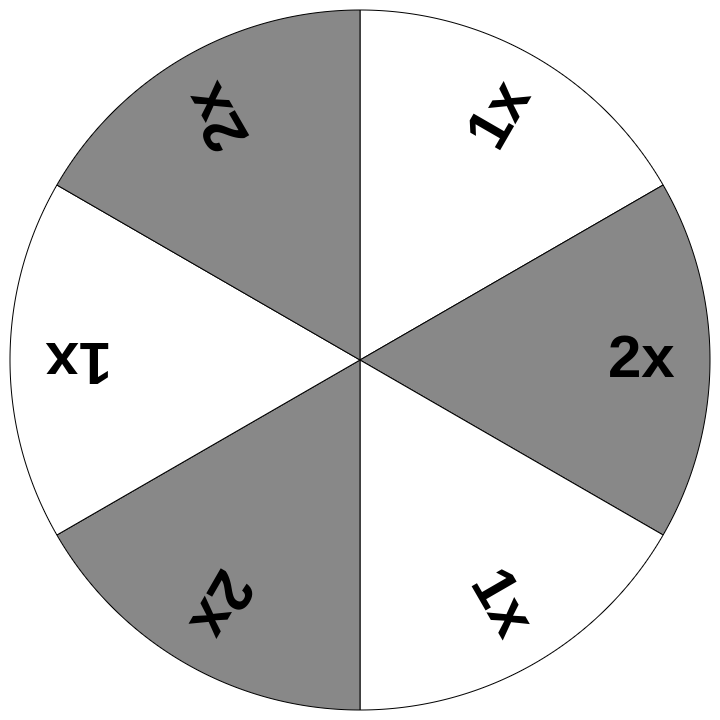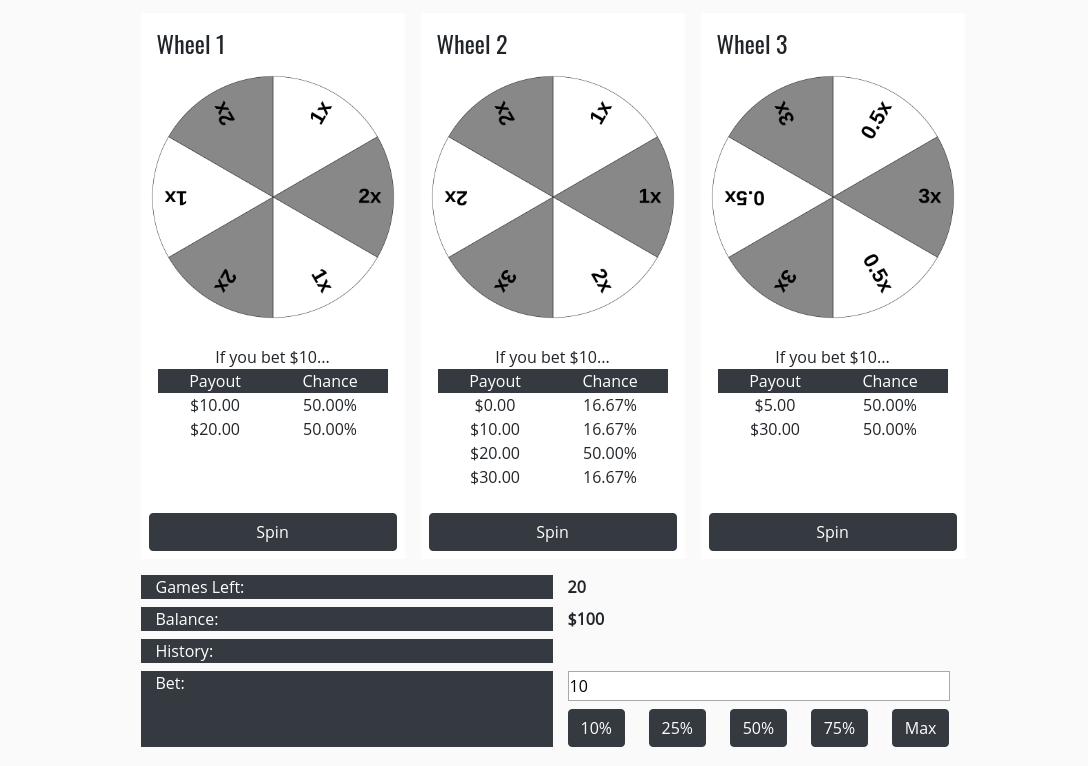Betting with Kelly - Risk of Ruins (Interactive Post)
Let's play roulette. There are 3 wheels of different payouts. Some wheels are riskier than others. You have a starting balance of $100 and may play 20 spins. Before each spins, you may choose the size of your bet and the wheel to spin. Your goal is to have the most amount of money at the end of 20 games.
The numbers on the wheel represent the payout per dollar bet. You may adjust your bet size in the input field below. Once you are happy with your bet size click on "Spin" on the corresponding wheel.
Go ahead and play the game below. But before you do, answer the following questions:
How well do you think you will do?
Which will be your favourite wheel?
The Game
Wheel 1

Wheel 2

Wheel 3

Playing like a pro
How well have you done on your first round? Do you think you can do better? If so, try your hands at it again until you are happy with your results.
If you have played it right, your average (or expected) balance at the end of the 20 games should be $96,400.
If you are not in that range and would like to figure out how to reach that balance at the end of the game, scroll up to the game before you read on to the spoiler.
Rolling your winnings
The simplest way to play this game is to roll your winnings. Amongst the 3 wheels, wheels 1 and 3 are the wheels that have no risk of ruins. That means there is exactly 0 probability that you will lose all your bet playing these two wheels.
This gets even more interesting with wheel 1 as you will never lose money on it. The minimum winning you get from spinning the wheel is the bet itself. That means it will be safe to bet your entire balance on wheel 1 each time.
By betting your entire balance on wheel 1 each time, you have a 50% chance of doubling your balance, and a 50% chance of not winning (or losing) anything. On an average of 20 spins, you will likely get 10 chance of doubling your balance - your initial balance will be multiplied 2 ^ 10 = 1,024 times!
Bring in the maths
You might have picked out that one could do the same with wheel 3 as well. So how do we compare the performance of the wheel given that our strategy is to always bet the entire balance?
The strategy is to calculate the geometric mean of the three wheels. To calculate the geometric mean, we simply take the nth root of the product of n numbers.
For example for wheel 1, the geometric mean is:

Wait, that's a different formula than what we were taught in school?
Indeed.
The other formula is more accurately named arithmetic mean and is not so useful to calculate compounding effects. Check out this article for a short discussion on the difference.
Expected returns on the wheels
Now that we can calculate the geometric means, let's take a look at the expected returns on the wheels after 20 spins.
To do that, simply raise the geometric mean to the 20th power!
For example, the expected returns for wheel 1 will be 1.41 ^ 20 = 964.68
For your convenience, below is the table of the results for the wheels:
| Wheel | Arithmetic mean | Geometric mean | Expected return (after 20 spins) |
|---|---|---|---|
| #1 | 1.50 | 1.41 | 964.68 * 100 = $96,468 |
| #2 | 1.67 | 0.00 | 0.00 * 100 = $0.00 |
| #3 | 1.75 | 1.22 | 53.36 * 100 = $5,336 |
We can point out two observations from here:
- Once there is a chance of losing the entire bet, the geometric mean and expected returns becomes zero.
- A small difference in geometric mean (1.41 vs 1.22) results in a huge difference in return after 20 spins.
Lessons learned
Why are we playing this game?
Each of these wheels represents different investable assets, and each spin at the wheel is simply the returns for a period of time your money stayed on that asset.
The purpose of this game is for me to illustrate a few concepts in investments in general:
- Compounding interest is real!
- Risk management is as important as picking the best-performing assets
Of course, the numbers on the wheels are exaggerated and some assumptions like zero risk of ruins are not realistic when companies goes into bankruptcy all the time.
And that brings me to...
What if there is a risk of ruins

Bet sizing (or risk management) strategy also exists for games with risk of ruins. Read the next interactive blog post where we remove wheels without 0 payouts and learn about Kelly Criterion!
Ps. If you find this interactive post helpful in helping you learn more about personal finance, please share it with your friends!
